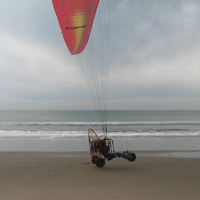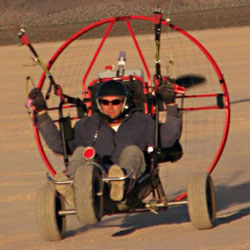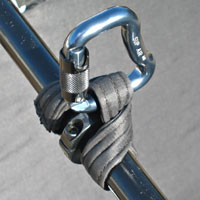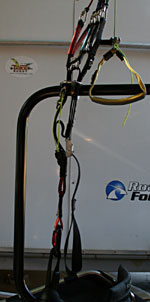Trikebuggy Hang Check Suggestions & Thoughts.

To balance the trike for flying, lift the trike just above above the ground from a secure source (tree, beam, flight simulator) by the caribiners and a stout rope or tie-down strap (anything that will not drop you and your trike onto the ground unexpectedly) and sit back comfortably in the seat with all your "goodies".
What we are really looking for is the perfect balance when pilot, fuel, accessories, instruments, mirrors, videos, camera's, etc are all loaded and the trike is brought just off the ground. Have someone look at the balance from the side of the trike. The front wheel should be slightly higher than the rear wheels when suspended with the pilot in the seat and gas in the tank.
|

The front wheel should be anywhere from 2" to 12" higher than the rear wheels off the ground. Different people prefer different angles, so I have expanded my thinking on this a bit, but typically, you want about 6 to 10 inches.
The reason you want this is because when you add throttle, there is more propeller exposed above the hangpoint than below it, and almost inevitably we get a bit of a push from the upper portion of the cage section, causing the trike to temporarily tilt forward and downward just a bit, even when it is adjusted properly.
This causes what we call a "wheelbarrow", and if the trike is not balanced properly, the resulting pressure can keep pressure on the front tire against the ground. |


Why is this bad? If the front tire does not come off the ground first, or returns to the ground first when landing, it will be very dificult to keep the trike steered straight and you will likely find the trike trying to steer itself and trying to flip over, since it is out of balance.
Look at the pictures on this page carefully, as they are all balanced very nicely. The front tire comes off the ground first, then the rear wheels follow. Upon landing, the rear wheels always touch down first, then the front wheel follows, allowing the pilot to establish a clear runway to follow (as long as they are landing into the wind, or landing in no wind).
When moving the Hang Point, adjust using small increments rather than large, and always measure from the rear upright or motor frame to be sure they are exactly the same distance from the motor frame. |
